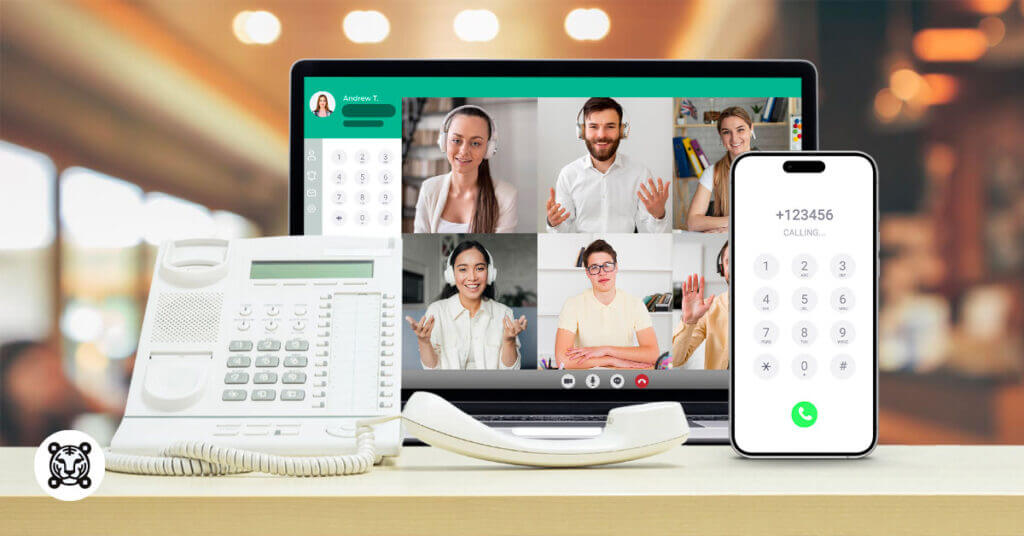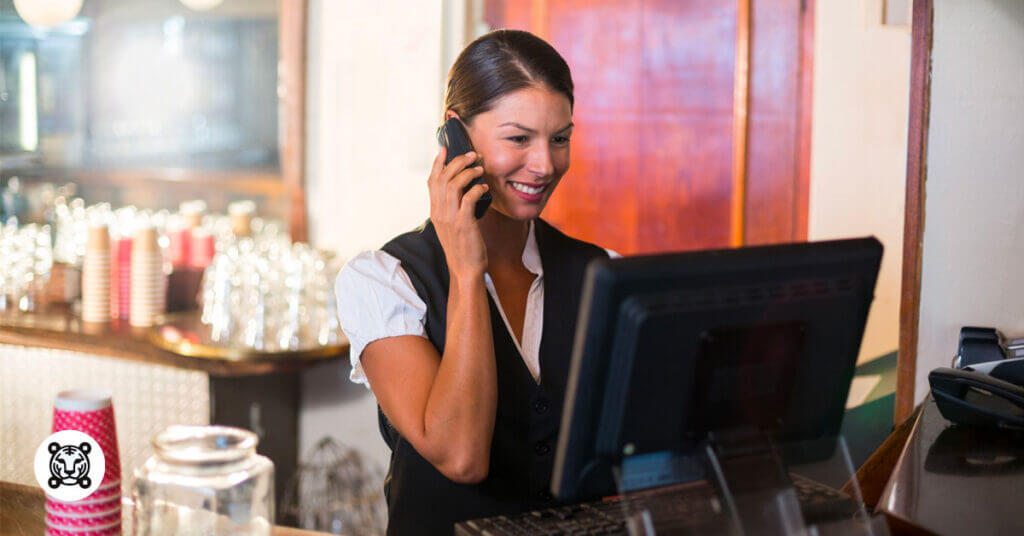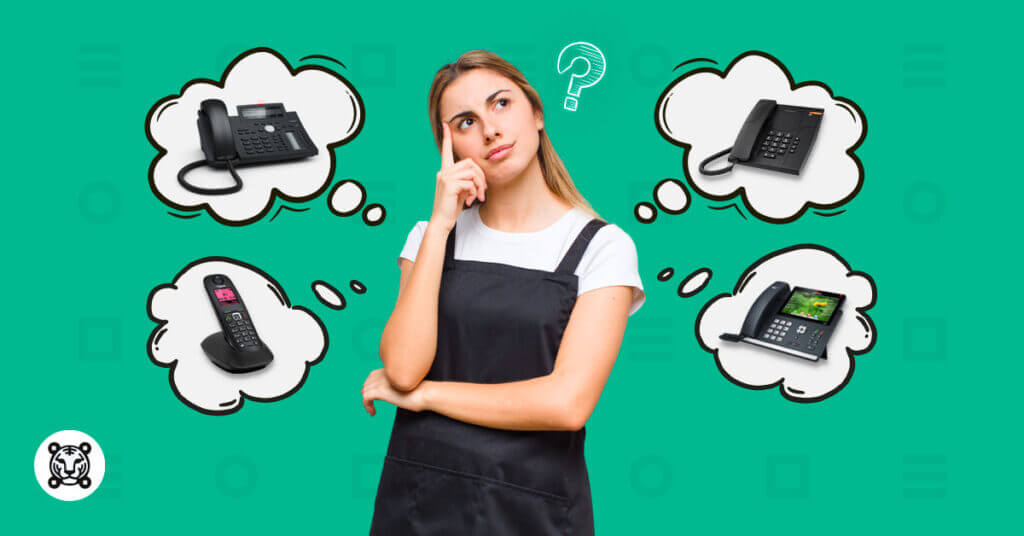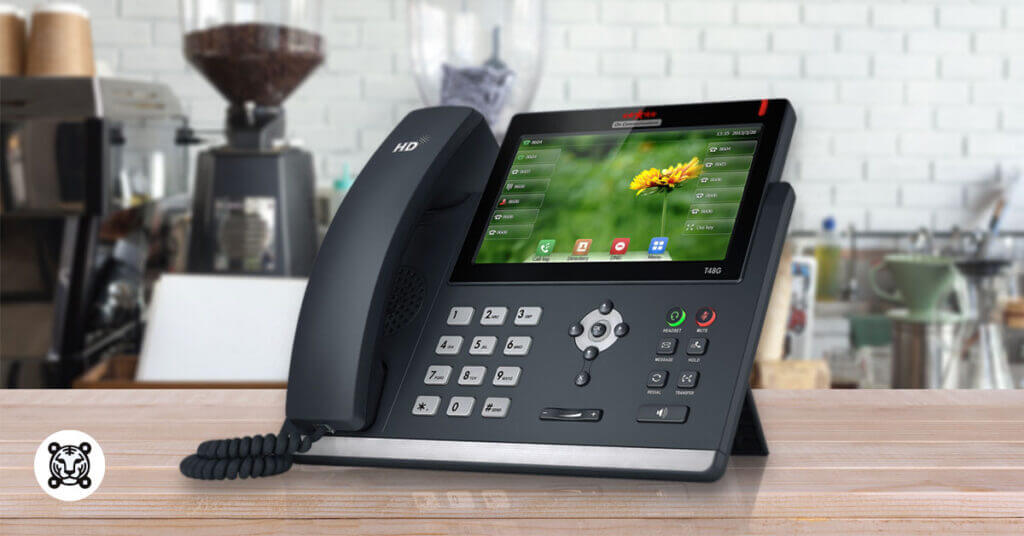
The Best Restaurant Phone Systems in 2025
Last Updated: November 25, 2025
Restaurant phone systems provide worry-free calling and communication features designed for sit-down restaurants, delivery services, catering, and food trucks.
Whether you’re new in this industry or have been serving your customers for decades, you know that effective communication is crucial for any business.
With a good phone system, communication is a smooth process.
Choosing and using a good phone system helps you manage orders, reservations, and other transactions — especially during peak hours — with so much ease.
Your goal is to spot the best one that suits your restaurant operation.
In this article, an interactive restaurant menu software provides elaborate information you should know when choosing the best phone system for your restaurant.
Types of restaurant phone systems
Before integrating a phone system for your restaurant, you first need to know the different types available.
Knowing this information can be considered a must-know guide to opening a restaurant.

Each caters to specific needs, and finding the right one would depend on your restaurant’s size, structure, and operational requirements.
KSU phones
Key Service Unit (KSU) phones, known as traditional business phone systems, are characterized by a physical cabinet that manages call routing. These are your basic phones.
KSU phone systems are suitable for smaller restaurants with straightforward communication needs.
So, if you run a local restaurant, bistro, bar, or shop, this is the best phone system for your restaurant.
Through these phones, you can access basic features such as call forwarding, conference calling, and voice mailing.
Private Branch Exchange (PBX) systems
PBX systems are more sophisticated and versatile, suitable for mid-sized to large restaurants.
A PBX system manages call routing internally and offers a range of features such as voicemail, call waiting, and conference calling.
Modern PBX systems can be physical on-site equipment or hosted in the cloud, providing flexibility for different business structures.
Voice-over Internet Protocol (VoIP) systems
VoIP systems leverage the internet to transmit voice data, offering flexibility and scalability.
These systems convert voice signals into digital data packets, allowing for cost-effective long-distance and international calls.
VoIP systems are ideal for restaurants of various sizes and are known for feature-rich solutions, including virtual receptionists, automated menus, and integration with other digital tools.
Top restaurant phone systems in 2025 that you should check out
In 2025, restaurants seeking efficient and reliable phone systems have several top-tier options to consider.
Here are some of the best systems tailored to the unique needs of the food service industry:
1. Talkroute
(Best for small to mid-sized restaurants seeking a virtual phone system)
Talkroute is a cloud-based virtual restaurant phone answering service system that allows restaurants to manage calls without the need for traditional landlines.
Since it's virtual, you don't need to install a hardware in your establishment. And unlike VoIP systems, it doesn't require an internet connection, making it more reliable in areas with spotty Wi-Fi.
It provides call forwarding, voicemail-to-email, and business texting features that make customer communication seamless.
This is best for independent restaurants, food trucks, or small chains looking for flexibility.
2. RingCentral
(Best for large restaurant chains and multi-location operations)
RingCentral is a cloud-based VoIP solution that offers a comprehensive communication platform, including phone, messaging, and video conferencing.
It seamlessly connects multiple locations under a single system, making it easy to manage communication across different branches.
Additionally, its automated attendant and IVR directs customers to the appropriate department (reservations, takeout orders, catering inquiries, etc.), reducing wait times.
It supports SMS, video calls, and even integration with online ordering platforms.
3. Ooma
(Best budget-friendly VoIP for small restaurants)
Ooma is a VoIP phone service that offers crystal-clear voice quality at a fraction of the cost of traditional business phone systems.
It's an excellent choice for small restaurants that need professional call handling without the high price tag.
What makes it stand out is its automated call distribution and virtual receptionist. With these features, you can ensure customers are routed to the right staff member or department.
And with its Wi-Fi calling and mobile app, you can take calls from anywhere, ensuring no missed orders from potential customers.
4. Nextiva
(Best for restaurants with high call volume and multi-channel needs)
Nextiva's VoIP services deliver robust call management features and integrate smoothly with CRM systems.
It's ideal for restaurants that handle a high volume of customer inquiries and reservations.
Now, its AI-powered call feature makes it a lot easier to track customer call patterns, flag missed calls, and automate follow-ups.
You can also sync it with customer databases, allowing you to track repeat customers and personalize service.
Their call queueing, voicemail transcription, and texting make it the best option for busy restaurants.
Their call queueing, voicemail transcription, and texting make it the best option for busy restaurants — a fact supported by numerous positive Nextiva reviews.
5. Dialpad
(Best for restaurants wanting AI-powered call assistance)
Dialpad is a VoIP system that leverages AI-driven voice intelligence to improve customer interactions. It is perfect for restaurants looking to enhance efficiency with smart automation.
Their AI voice intelligence provides real-time call transcriptions, keyword tracking, and sentiment analysis. It can also recognize and log takeout or delivery orders.
Plus, it's compatible with multiple devices. It works on mobile, tablet, and desktop, ensuring flexibility for staff.
Benefits of using a phone system for restaurant efficiency and service

Now, let’s explore the benefits that come with investing in a customized phones for restaurants.
These advantages extend beyond mere convenience, impacting various facets of your restaurant operations.
Efficient order processing
One of the most notable advantages of implementing an automated phone system for your restaurant is its capacity to enhance the efficiency of food order processing.
This contributes to a smoother workflow for your staff while ensuring a seamless, error-free experience for your valued customers.
Enhanced customer service
A restaurant’s ability to handle reservations efficiently plays a pivotal role in the overall customer experience.
With modern phone systems, reservation management becomes a breeze.
For instance, automated reservation systems allow your customers to book tables easily, reducing the likelihood of missed reservations and ensuring you get a smooth service flow.
Operational streamlining
Instead of learning how to scan a menu online or in your physical stores, customers will have a convenient alternative to faster ordering. And this also makes your restaurant operations easier.
Integrating the best phone system for small restaurants and large ones seamlessly consolidates important functions such as reservations, order processing, and staff management.
By centralizing these operations, you can monitor and coordinate activities using a single platform.
This integration reduces the chances of errors and streamlines communication between different facets of the business.
Adaptability to trends
MadMobile, a tech company for the restaurant industry, emphasizes the growing significance of online ordering and reservations with a substantial increase in customer preference for these conveniences.
Automated phones for restaurants that seamlessly adapts to these trends caters to evolving customer behaviors and ensures operational efficiency.
By aligning with such trends, your restaurant business meets customer expectations and positions itself as a tech-savvy contender in the competitive restaurant market.
How to choose a restaurant phone system

Choosing the best restaurant phone system involves several criteria and factors to ensure it aligns with your specific needs and provides the functionality required for efficient operations.
Here are key factors you should consider:
Ease of use
An easy-to-use phone system reduces the learning curve for your staff, enabling quicker onboarding and minimizing training time.
This is particularly crucial in an industry where staff turnover can be relatively high.
Additionally, it aids in providing faster customer service.
Since your staff members can efficiently navigate the phone system, they can promptly and accurately assist your customers.
They won’t have a hard time processing your restaurant order system, managing reservations, and accessing further restaurant information without delays.
This results in minimized errors and quick adaptability to high-stress situations.
Integration capabilities
When looking for software for your restaurants, it’s important to consider those that easily integrate with other existing software as well.
Suppose you have a point-of-sale (POS) system, online reservation tool, and customer relationship management (CRM) tool activated in your restaurant.
You need to choose a phone system that lets you seamlessly automate and integrate with these existing systems.
This is because a great software integration streamlines communication and data flow and improves operational efficiency.
As a result, you’ll benefit from reduced manual tasks, freeing up your staff to focus on delivering top-notch service.
Scalability
A business phone’s scalability refers to the system’s ability to handle increased usage, additional features, and a growing number of users without compromising performance.
This is the ultimate feature that helps you navigate through the changes as you progress in the industry.
Think of it this way: As your restaurant gains popularity and expands, the volume of calls, reservations, and orders is likely to increase.
A scalable phone system ensures your communication infrastructure can effortlessly accommodate the heightened demand without experiencing bottlenecks or disruptions.
Customization options
When talking about restaurant operations, no two establishments should be identical.
Each venue possesses its unique atmosphere, paper and QR code menu offerings, and customer service approach.
Consequently, when it comes to choosing a phone system for your restaurant, the ability to customize and tailor the system to meet the specific needs of your establishment becomes a crucial factor.
You should look for the phone system that helps in achieving these tasks:
- Meet menu and service specifics
- Adapt to peak hours and events
- Tailor call scripts and promotions
- Personalize customer interactions
- Scale with growth and changes
The available customization options should allow you to mold your phone system to align precisely with the unique characteristics and operational nuances of your restaurant.
Security features
A restaurant’s phone system is one of the gateways to accessing critical business information, such as your customer's personal details and credit and debit card information, making it a target for malicious activities if not adequately fortified.
Many people aren’t even aware that services like cyber extortion coverage exist, yet they can play a vital role in protecting against modern digital threats.
As the owner or manager, it’s your main job to protect every bit of information you have about your customers and your business.
The best way to do this lies in choosing the software that offers top-tier security features.
Look for a phone calling system that employs encryption protocols to safeguard critical customer information during transactions.
Moreover, it’s even better if the system provides a detector tool or feature that helps you spot and stop fraudulent activities such as phone spoofing and identity theft.
If you’re looking for additional ways to protect sensitive information, Cybernews has reviewed some of the top identity theft protection solutions to help safeguard your business and customers.
Analytics and reporting
When selecting a restaurant phone answering system, you also need to consider its ability to gather and analyze call log data.
Information such as call durations and recordings lets you analyze customer interaction and identify the areas where you need to improve your customer and order-handling strategies.
Not only that, but the insights also allow you to make data-driven decisions regarding staffing, marketing strategies, and overall business operations.
It will also help you optimize peak hours and better manage staff schedules.
Upgradability and future-proofing
The restaurant industry is continuously shaped by emerging trends, and your chosen phone system should be able to keep up with it.
A phone system that can evolve with your restaurant business ensures that you can effortlessly incorporate additional features in the future.
For instance, a provider offering regular updates might introduce advanced analytics tools, food ordering software, encryption updates, and mobile payment processing enhancements to refine the phone service.
The upgradability of the system is the indicator that you’re investing in the right tool for your restaurant.

How to set up a restaurant phone answering system
The right business phone setup guarantees seamless operations, effective customer interactions, and the flexibility to adapt to industry changes.

Here’s a step-by-step guide to help you navigate the process:
Define your needs and objectives
Consider the size of your establishment, the volume of calls you expect, and any specific features crucial for your operations, such as online reservations, order processing, and customer relationship management.
Choose the right type of restaurant phone system
Select the type of phone system that aligns with your restaurant’s size and requirements.
If you’re a smaller restaurant, a traditional KSU might be good enough to handle the inflow of daily calls.
For more extensive operations, consider a PBX or VoIP system for enhanced features and scalability.
Select compatible phones
Once you’ve determined the type of system, choose the phones that are compatible.
For instance, if you opt for a VoIP system, select phones that support this restaurant technology.
Consider features like cordless options for staff mobility, multiple-line phones for call management, and speakerphones for hands-free communication.
Choose a reliable provider
Research providers that offer the features you need, good customer support, and a commitment to upgradability.
Look for user reviews and testimonials to gauge the satisfaction of other restaurant owners with the provider’s services.
Ensure integration with other tools
If you use other tools, such as a restaurant POS system, digital restaurant menu QR code, or online ordering platforms, make sure that your chosen phone system can seamlessly integrate with these tools.
Consider cloud-based solutions
Cloud-based phone systems offer flexibility and accessibility.
Consider whether a cloud-based solution aligns with your restaurant’s needs, as it allows for remote management and can be especially beneficial for multi-location establishments.
Installation and configuration
Work with the chosen provider to install and configure the phone system.
This may involve setting up the physical equipment, configuring software settings, incorporating an automated restaurant waiter call button system, and ensuring that all phones are connected and functional.
Staff training
Make sure that your staff is well-trained in using the new phone system.
You may onboard them on understanding the features, call handling procedures, and any additional tools or software associated with the system.
Test and optimize
Conduct thorough testing of the system to identify and address any issues.
Optimize configurations based on feedback from staff and customers, ensuring that the system aligns with your restaurant’s evolving needs.

MENU TIGER QR code menu's rundown
The right restaurant phone system is more than a technological asset, it’s a strategic investment that ensures your restaurant keeps pace and delivers exceptional customer experience.
From managing reservations to facilitating smooth order processing, it helps you streamline communication and enhance operational efficiency.
Plus, you can also easily integrate it with other software.
This means that if you have technologies like a QR code menu, it won’t be a headache to integrate them and offer a restaurant service like no other.
FAQ
Belle
Belle Boralo is a seasoned Content Writer specializing in SaaS and marketing content, known for boosting website traffic. Her background in writing essays and journalism and her love for the outdoors infuse her work with a unique and vibrant energy.


